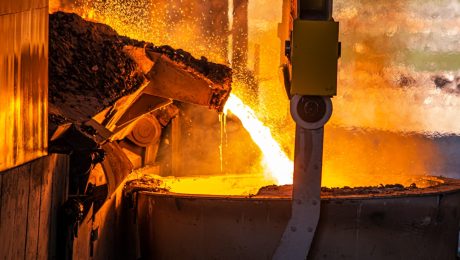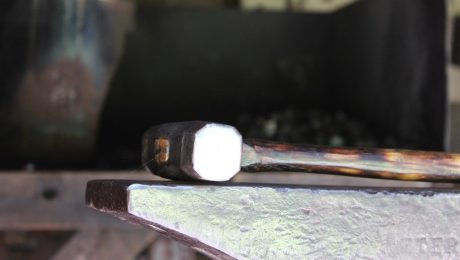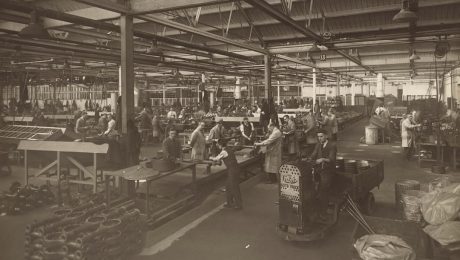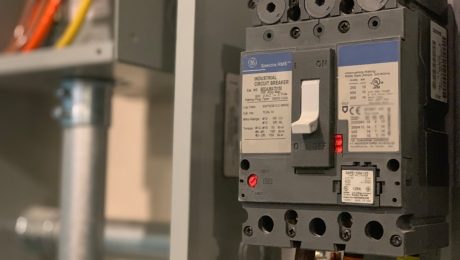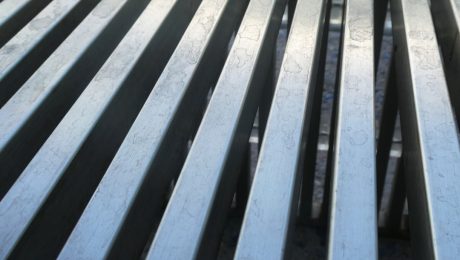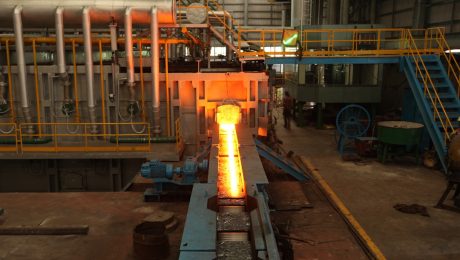Project-based steel manufacturing represents a significant shift from traditional mass production. Instead of churning out standardized components, this approach focuses on delivering bespoke steel solutions tailored to the specific needs of individual projects. This requires a higher level of customization, precision, and project management expertise. This post delves into the intricacies of this dynamic field, exploring its key aspects and the challenges involved.
1. Design and Engineering: The Blueprint for Success
The foundation of any successful project-based steel manufacturing endeavor lies in meticulous design and engineering. This phase involves close collaboration between the manufacturer, the client, and potentially architects and engineers. Detailed specifications are crucial, encompassing everything from material selection (grade of steel, thickness, surface finish) to intricate dimensional requirements and tolerances. Advanced Computer-Aided Design (CAD) and Building Information Modeling (BIM) software plays a vital role in creating accurate 3D models, facilitating efficient communication, and minimizing errors. Detailed shop drawings, including fabrication and assembly instructions, are generated to guide the production process. This collaborative design phase ensures that the final product perfectly aligns with the client’s vision and project specifications, minimizing costly revisions and delays.
2. Fabrication: Precision and Efficiency in Steel Shaping
Once the design is finalized, the fabrication phase begins. This involves transforming raw steel into the required components using various techniques, including cutting (laser, plasma, waterjet), bending, rolling, welding (MIG, TIG, submerged arc), and drilling. The choice of fabrication method depends on factors like the complexity of the design, material properties, and desired tolerances. Project-based manufacturing often necessitates the use of advanced CNC (Computer Numerical Control) machinery for precise and repeatable cuts and bends. Quality control is paramount during this stage; rigorous inspections ensure that each component meets the specified standards. Efficient workflow management, including the optimal sequencing of operations, is critical to minimizing lead times and maximizing productivity.
3. Project Management: Orchestrating a Seamless Process
Project-based steel manufacturing requires robust project management skills. This involves coordinating various aspects of the project, from material procurement and fabrication to logistics and delivery. Effective communication is essential, keeping all stakeholders informed about progress, potential challenges, and any necessary adjustments. Utilizing project management software allows for better tracking of timelines, resources, and costs. Risk management is critical, anticipating potential delays or problems and developing contingency plans. Regular progress meetings and thorough documentation ensure transparency and accountability throughout the project lifecycle. A successful project manager ensures that the project is completed on time, within budget, and to the client’s satisfaction.
4. Quality Control and Assurance: Ensuring Excellence in Every Component
Maintaining high quality standards is non-negotiable in project-based steel manufacturing. This involves rigorous quality control checks at each stage of the process, from incoming material inspection to final product verification. Non-destructive testing (NDT) techniques, such as ultrasonic testing and radiographic testing, may be employed to detect internal flaws. Dimensional accuracy is verified using precise measuring instruments. A well-defined quality management system (QMS), often aligned with ISO 9001 standards, ensures consistent quality and traceability. This commitment to quality not only safeguards the integrity of the final product but also enhances the reputation and credibility of the manufacturer.
5. Logistics and Delivery: Getting the Steel Where It Needs To Be
The final stage involves the efficient transportation and delivery of the fabricated steel components to the project site. This requires careful planning, considering factors like component size and weight, accessibility of the site, and potential logistical challenges. Specialized transportation equipment, such as heavy-duty trucks and cranes, might be necessary for larger or more complex components. Accurate scheduling and coordination with the construction team are crucial to ensure timely delivery and minimize disruption on site. Proper packaging and handling procedures protect the components from damage during transit. Effective logistics management ensures that the steel components arrive safely and on schedule, contributing to the overall success of the project.
Project-based steel manufacturing presents unique challenges, but the rewards are significant. By embracing advanced technologies, implementing robust project management strategies, and maintaining an unwavering commitment to quality, manufacturers can successfully navigate this demanding field and deliver exceptional results. The ability to create bespoke steel solutions opens doors to a wider range of projects and opportunities, establishing a strong competitive advantage in the market.
SEO Tags:
- Project-based steel manufacturing
- Custom steel fabrication
- Steel construction projects
- Steel project management
- Bespoke steel solutions
body {
font-family: sans-serif;
line-height: 1.6;
}
h1, h2, h3 {
color: #333;
}
h1 {
font-size: 2.5em;
}
h2 {
font-size: 2em;
}
h3 {
font-size: 1.5em;
}
The choice between concrete and steel is a fundamental decision in any construction project. Both materials offer unique properties, advantages, and disadvantages that significantly impact the project’s cost, durability, and overall design. This comprehensive guide delves into the key differences between these two titans of the construction world, helping you understand which material is best suited for your needs.
Strength and Durability: A Head-to-Head Comparison
Concrete, a composite material made of cement, aggregates, and water, boasts exceptional compressive strength. This means it excels at resisting crushing forces. However, its tensile strength (resistance to pulling forces) is significantly lower. Steel, on the other hand, possesses outstanding tensile strength, making it ideal for applications requiring flexibility and resistance to bending and stretching. While steel can be susceptible to corrosion, advancements in protective coatings and galvanization have mitigated this significantly. Concrete’s durability is largely dependent on the quality of its mix and proper curing. Both materials can achieve remarkable longevity when properly engineered and maintained, but their strengths lie in different areas.
Cost Analysis: Weighing the Economic Factors
The cost of concrete and steel can vary significantly depending on location, market conditions, and the specific type of material used. Generally, concrete is often perceived as a more cost-effective option for large-scale projects like foundations and massive structures. The initial cost of materials is typically lower for concrete. Steel, while potentially more expensive upfront, can sometimes offer cost savings in terms of labor and construction time, particularly in high-rise buildings where its lighter weight allows for faster erection. Transportation costs also play a significant role, as steel is generally easier to transport in prefabricated sections compared to bulk concrete.
Structural Applications: Where Each Material Shines
Concrete’s compressive strength makes it the preferred choice for foundations, columns, and walls in many structures. Its ability to form complex shapes also contributes to its versatility in architectural design. However, the need for reinforcement with steel bars (rebar) is often necessary to enhance its tensile strength and prevent cracking under stress. Steel, with its high tensile strength and flexibility, is indispensable in the construction of high-rise buildings, bridges, and long-span structures. Its lightweight nature also makes it suitable for applications where minimizing weight is crucial, such as in aircraft hangars or large-scale industrial facilities.
Environmental Impact: Sustainability Considerations
The environmental impact of both concrete and steel is a growing concern in the construction industry. Concrete production is a significant contributor to greenhouse gas emissions due to the energy-intensive process of cement manufacturing. However, advancements in low-carbon cement and the use of recycled materials are striving to reduce its carbon footprint. Steel production also has a significant environmental impact, primarily due to the energy consumption in the smelting process and the emission of pollutants. Recycling steel is a much more efficient process than recycling concrete, making it a more sustainable choice in certain aspects. The overall environmental impact depends on several factors, including the sourcing of materials, transportation distances, and the energy efficiency of the construction process.
Maintenance and Lifespan: Long-Term Considerations
Concrete structures require minimal maintenance, typically involving periodic inspections for cracking or damage. However, exposure to harsh weather conditions or chemical spills can degrade concrete over time. Steel structures, while durable, are susceptible to corrosion if not properly protected. Regular inspections and maintenance, including repainting or applying protective coatings, are crucial to extend the lifespan of steel structures. Proper design and construction practices are vital for both materials to ensure their longevity and minimize the need for extensive repairs. The choice of material often involves a trade-off between initial cost and long-term maintenance expenses.
In conclusion, the decision of whether to use concrete or steel is not a simple one. It depends on a complex interplay of factors, including structural requirements, budget constraints, environmental considerations, and the specific project goals. A thorough analysis of each material’s properties and limitations is essential for making an informed decision that leads to a successful and sustainable construction project.
SEO Tags:
Concrete, Steel, Construction Materials, Structural Engineering, Building Materials
body {
font-family: sans-serif;
line-height: 1.6;
}
h1, h2, h3 {
color: #333;
}
h1 {
font-size: 2.5em;
}
h2 {
font-size: 2em;
}
h3 {
font-size: 1.5em;
}
Cold drawn round steel bars are a cornerstone of numerous industries, offering a combination of high precision, superior mechanical properties, and excellent surface finish. This comprehensive guide delves into the intricacies of these versatile steel products, exploring their manufacturing process, unique characteristics, and diverse applications.
The Cold Drawing Process: Precision Engineering at its Finest
Unlike hot-rolled steel bars, which are shaped at high temperatures, cold drawn steel bars undergo a process of deformation at room temperature. This process involves pulling a pre-rolled steel bar through a series of dies with progressively smaller diameters. The reduction in diameter increases the tensile strength and yield strength significantly. This cold working process also refines the grain structure, resulting in improved surface finish and dimensional accuracy. The process typically involves several stages, with intermediate annealing cycles to relieve stresses and prevent work hardening from becoming excessive. Lubricants are crucial in reducing friction and wear during the drawing process, ensuring consistent quality and preventing surface defects.
Exceptional Mechanical Properties: Strength and Durability Redefined
The cold drawing process dramatically enhances the mechanical properties of the steel. The resulting bars boast significantly higher tensile strength and yield strength compared to their hot-rolled counterparts. This increased strength makes cold drawn round steel bars ideal for applications demanding high load-bearing capacity and resistance to deformation. Furthermore, the cold drawing process improves the bar’s fatigue resistance and ductility, enhancing its overall durability and lifespan. Specific mechanical properties can be tailored by adjusting the drawing parameters and the initial composition of the steel, allowing for customized solutions to meet specific application needs.
Diverse Applications: From Automotive to Construction
The superior properties of cold drawn round steel bars make them incredibly versatile. They find extensive use in various industries, including:
- Automotive: Used in components such as axles, shafts, connecting rods, and steering components, where high strength and precision are critical.
- Construction: Used in reinforcing bars for concrete structures, as well as in various structural components requiring high tensile strength.
- Machinery Manufacturing: Employed in the production of spindles, shafts, pins, and other machine components that need to withstand significant stresses.
- Aerospace: Used in applications where lightweight yet high-strength materials are needed, such as aircraft landing gear and structural components.
- Hydraulic and Pneumatic Systems: Used in the manufacturing of hydraulic cylinders and pneumatic components, where precise dimensions and high strength are crucial.
Advantages of Cold Drawn Round Steel Bars: Why Choose Cold Drawn?
Several key advantages make cold drawn round steel bars a preferred choice in many applications:
- High Strength and Durability: Significantly higher tensile and yield strength compared to hot-rolled bars.
- Superior Surface Finish: Smoother surface with improved dimensional accuracy.
- Enhanced Machinability: Easier to machine and process, reducing manufacturing time and costs.
- Improved Fatigue Resistance: Greater resistance to repeated stress cycles.
- Precise Dimensions: Close tolerance dimensions, minimizing the need for secondary machining.
Understanding Specifications and Grades: Selecting the Right Steel
Cold drawn round steel bars are available in various grades and specifications, each designed for specific applications. These specifications typically include details such as diameter, length, material grade (e.g., 1018, 1045, 4140), and mechanical properties. Understanding these specifications is crucial for selecting the appropriate steel bar for a given project. Consult relevant industry standards and material datasheets to ensure the chosen steel meets the required performance criteria. Factors to consider include the desired tensile strength, yield strength, hardness, and ductility. Working closely with a steel supplier can help navigate the complexities of selecting the optimal grade and specification for your specific application.
Cold drawn round steel bars are a testament to the power of precision engineering. Their exceptional properties and versatility make them indispensable across a multitude of industries. By understanding their manufacturing process, mechanical properties, applications, and specifications, engineers and designers can harness the full potential of these high-performance materials.
SEO-Friendly Tags:
- Cold Drawn Steel Bars
- Round Steel Bars
- Steel Bar Manufacturing
- High Strength Steel Bars
- Precision Steel Bars
Cold drawn round steel bars are ubiquitous in various industries, renowned for their superior strength, precision, and excellent surface finish. This comprehensive guide delves into the intricacies of these versatile materials, exploring their manufacturing process, properties, applications, advantages, and specifications. Understanding these aspects is crucial for engineers, manufacturers, and anyone working with high-performance steel components.
The Cold Drawing Process: Shaping Steel with Precision
Unlike hot-rolled steel bars, which are shaped at high temperatures, cold drawn steel bars undergo a process of deformation at room temperature. This process begins with a hot-rolled bar, which is then subjected to a series of controlled reductions in diameter by pulling it through a series of dies. The dies are precisely engineered to achieve the desired final dimensions and tolerances. This cold working process significantly alters the steel’s microstructure, leading to enhanced mechanical properties.
The process involves several key steps: pickling (removing surface oxides), drawing (reducing diameter through dies), straightening (eliminating bending and warping), and finally, cutting to the required lengths. The precise control during each stage ensures exceptional dimensional accuracy and surface quality, resulting in bars with tighter tolerances compared to hot-rolled counterparts.
Different lubricants are used during the drawing process to minimize friction and wear on both the bar and the dies. The choice of lubricant significantly impacts the final surface finish and the efficiency of the process.
Exceptional Mechanical Properties: Strength and Durability
The cold drawing process dramatically improves the mechanical properties of the steel. The deformation causes strain hardening, increasing the tensile strength, yield strength, and hardness of the material. This enhanced strength translates to greater durability and resistance to deformation under load. Cold drawn steel bars exhibit higher fatigue strength compared to hot-rolled bars, making them ideal for applications involving cyclic loading.
Specific mechanical properties, such as tensile strength, yield strength, elongation, and hardness, are highly dependent on the grade of steel used and the degree of cold work. Detailed specifications are usually provided by the manufacturer, allowing for precise selection based on the application requirements.
The improved surface finish also contributes to increased fatigue resistance by reducing stress concentration points that might initiate cracks.
Diverse Applications: Where Cold Drawn Steel Bars Excel
The combination of high strength, precision dimensions, and excellent surface finish makes cold drawn round steel bars suitable for a wide array of applications across various industries. These applications range from simple components to complex machinery parts.
Automotive Industry: Cold drawn steel bars are extensively used in automotive parts, including axles, shafts, connecting rods, and steering components, where high strength and durability are critical.
Machinery and Equipment: They find application in various machinery components, such as spindles, shafts, pins, and hydraulic cylinders, requiring precise dimensions and high resistance to wear and tear.
Construction and Infrastructure: While less common in large structural applications, cold drawn steel bars are used in specialized components where high strength and precision are necessary.
Aerospace: In aerospace applications, the high strength-to-weight ratio of cold drawn steel bars makes them suitable for lightweight yet robust components.
Advantages Over Other Steel Bar Types: Why Choose Cold Drawn?
Compared to hot-rolled steel bars, cold drawn steel bars offer several significant advantages:
- Higher Strength and Hardness: The cold drawing process significantly enhances the mechanical properties.
- Improved Surface Finish: Cold drawn bars possess a smoother, more precise surface finish.
- Tighter Tolerances: Dimensional accuracy is significantly better, reducing the need for secondary machining.
- Enhanced Fatigue Resistance: The smoother surface and improved microstructure contribute to higher fatigue life.
- Increased Machinability: The improved surface finish can improve machinability in some cases.
However, it’s important to note that cold drawn steel bars are generally more expensive than hot-rolled bars due to the more complex manufacturing process.
Specifications and Standards: Ensuring Quality and Consistency
Cold drawn round steel bars are manufactured to various specifications and standards to ensure consistent quality and performance. These standards define the chemical composition, mechanical properties, dimensional tolerances, and surface finish requirements. Common standards include ASTM A108, ASTM A570, and other industry-specific standards.
Understanding these specifications is crucial for selecting the appropriate steel bar for a given application. Factors such as the grade of steel (e.g., 1018, 1045), diameter, length, and surface finish should be carefully considered. Working with reputable suppliers who adhere to these standards is essential to ensure the quality and reliability of the materials.
The specifications also often include information on testing procedures to verify the properties of the finished bars.
Cold drawn round steel bars are a critical component in many industries, offering a unique combination of strength, precision, and durability. By understanding their manufacturing process, properties, and applications, engineers and manufacturers can leverage their full potential to create high-performance components.
Tags: cold drawn steel bars, round steel bars, steel bar manufacturing, cold drawing process, steel bar applications
Power plants, the behemoths of energy generation, demand robust and reliable construction. At the heart of this infrastructure lies a critical component: steel profiles. These precisely engineered shapes of steel provide the structural backbone, support critical equipment, and ensure the safe and efficient operation of these complex facilities. This post delves into the multifaceted role of steel profiles in power plant construction, exploring their various applications, benefits, and the considerations involved in their selection and implementation.
1. Structural Frameworks: The Backbone of Power Plant Construction
Steel profiles form the fundamental structural framework of most power plants. From the main building structures to supporting towers for transmission lines, their high strength-to-weight ratio makes them ideal for creating large, stable structures that can withstand significant loads and environmental stresses. Commonly used profiles include H-beams (wide-flange beams), I-beams, and channels, which are welded or bolted together to create complex frameworks. The design process considers factors such as wind loads, seismic activity, and the weight of equipment to ensure structural integrity and longevity. Advanced computer-aided design (CAD) and finite element analysis (FEA) are employed to optimize designs for maximum efficiency and cost-effectiveness.
2. Specialized Applications: Beyond the Structural Framework
Beyond the main structural elements, steel profiles find application in numerous specialized areas within power plants. For example, they are crucial in the construction of:
- Boiler supports: The massive boilers used in thermal power plants require robust support structures, often fabricated from heavy-duty steel profiles designed to withstand extreme temperatures and pressures.
- Turbine foundations: Turbines, the heart of power generation, require exceptionally stable foundations to minimize vibrations and ensure efficient operation. Steel profiles are often used in conjunction with concrete to create these foundations.
- Cooling tower structures: Steel profiles play a vital role in the construction of cooling towers, providing the framework for these large structures which are essential for dissipating heat from the power generation process.
- Transmission line towers: The transmission of electricity from the power plant to the grid requires tall, sturdy towers. Steel profiles are frequently used in their construction to withstand wind loads and maintain the integrity of the transmission lines.
- Crane runways and support structures: Heavy-duty cranes are vital for maintenance and construction within power plants. Steel profiles form the tracks and supports for these cranes, ensuring safe and efficient operation.
3. Material Selection: Choosing the Right Steel for the Job
The selection of appropriate steel profiles is crucial for ensuring the longevity and performance of power plant structures. Factors to consider include:
- Grade of steel: Different grades of steel offer varying levels of strength, ductility, and weldability. Higher-strength steels are often preferred for critical applications to minimize weight and maximize load-bearing capacity.
- Corrosion resistance: Power plants operate in environments that can be harsh and corrosive. The choice of steel should consider factors such as exposure to moisture, chemicals, and high temperatures. Galvanized steel or stainless steel profiles might be necessary in corrosive environments.
- Weathering steel: In certain applications, weathering steel (also known as corten steel) can be a cost-effective option. This type of steel develops a protective rust layer that inhibits further corrosion.
- Fabrication considerations: The ease of fabrication should also be considered. Some steel profiles might be easier to weld or bolt than others, impacting construction time and cost.
4. Fabrication and Construction Techniques: Precision and Efficiency
The fabrication and construction of steel structures for power plants require precision and adherence to strict safety standards. Modern fabrication techniques, such as laser cutting, robotic welding, and advanced bolt connections, ensure accuracy and efficiency. Detailed engineering drawings and rigorous quality control procedures are essential throughout the process. Experienced and skilled welders and fabricators are vital to ensure the structural integrity of the completed structures.
5. Cost-Effectiveness and Sustainability: Balancing Performance and Environmental Impact
While steel profiles represent a significant investment, their long lifespan and robust performance make them a cost-effective solution in the long run. The use of recycled steel also contributes to the sustainability of power plant construction. Furthermore, advancements in steel production and fabrication technologies are continuously improving the efficiency and environmental impact of steel profiles, minimizing waste and energy consumption.
In conclusion, steel profiles are indispensable components in the construction and operation of power plants. Their versatility, strength, and durability ensure the structural integrity and safe operation of these crucial energy infrastructure assets. The careful selection of appropriate materials, the precise fabrication techniques, and the consideration of cost-effectiveness and sustainability are all essential factors in maximizing the benefits of steel profiles in power plant construction.
SEO Tags:
- Steel Profiles
- Power Plant Construction
- Structural Steel
- Industrial Steel Fabrication
- Energy Infrastructure
In today’s competitive global market, maintaining high-quality products and efficient production processes is crucial for success. Implementing ISO-compliant systems offers a structured framework to achieve these goals, boosting productivity, reducing waste, and enhancing customer satisfaction. This comprehensive guide delves into the intricacies of ISO-compliant production processes, providing valuable insights for businesses of all sizes.
Understanding ISO Standards and Their Relevance to Production
ISO (International Organization for Standardization) develops and publishes international standards. Several ISO standards are directly relevant to production processes, with ISO 9001 (Quality Management Systems) being the most widely adopted. This standard provides a framework for establishing, implementing, maintaining, and continually improving a quality management system. Other relevant standards include ISO 14001 (Environmental Management Systems), focusing on minimizing environmental impact, and ISO 45001 (Occupational Health and Safety Management Systems), prioritizing employee well-being. Adherence to these standards demonstrates a commitment to excellence, attracting customers who value quality, sustainability, and ethical practices. The benefits extend beyond reputation; compliance often leads to reduced costs through improved efficiency and waste reduction.
Implementing a Robust Quality Management System (QMS)
The core of ISO-compliant production lies in a robust Quality Management System (QMS). This system involves defining clear processes, responsibilities, and procedures for every stage of production, from raw material procurement to final product delivery. A well-defined QMS includes:
- Process Mapping: Visually documenting each step of the production process to identify bottlenecks and areas for improvement.
- Documentation Control: Maintaining accurate and up-to-date records of all processes, procedures, and quality data.
- Internal Audits: Regularly assessing the effectiveness of the QMS through internal audits to identify non-conformities and areas needing attention.
- Corrective and Preventive Actions (CAPA): Implementing procedures to address identified non-conformities and prevent their recurrence.
- Management Review: Regularly reviewing the performance of the QMS to ensure its continued effectiveness and alignment with business objectives.
A strong QMS ensures consistent product quality and reduces the risk of defects, leading to increased customer satisfaction and reduced costs associated with rework and waste.
Integrating Lean Manufacturing Principles
Lean manufacturing principles, focusing on eliminating waste and maximizing efficiency, are highly compatible with ISO standards. Integrating lean methodologies into your production processes can significantly enhance your ISO compliance efforts. This involves techniques such as:
- Value Stream Mapping: Identifying and eliminating non-value-added steps in the production process.
- 5S Methodology: Organizing the workplace to improve efficiency and reduce waste (Sort, Set in Order, Shine, Standardize, Sustain).
- Kaizen (Continuous Improvement): Continuously seeking small improvements in processes to enhance efficiency and quality.
- Just-in-Time (JIT) Inventory: Minimizing inventory levels to reduce storage costs and waste.
By implementing lean principles, businesses can streamline their production processes, reduce costs, and improve overall efficiency, all of which contribute to a more robust and effective ISO-compliant system.
Ensuring Traceability and Product Identification
Maintaining complete traceability throughout the production process is crucial for ISO compliance. This involves accurately tracking and documenting all materials, processes, and personnel involved in the creation of each product. Effective traceability allows for:
- Rapid Identification of Defects: Quickly identifying the source of defects to facilitate corrective actions.
- Product Recalls: Efficiently managing product recalls by identifying and isolating affected products.
- Improved Quality Control: Monitoring production processes and identifying areas for improvement.
- Enhanced Customer Confidence: Demonstrating a commitment to quality and transparency.
Implementing barcoding, RFID tagging, or other tracking systems can significantly improve traceability and ensure compliance with ISO standards.
Continuous Improvement and the ISO Cycle
ISO compliance is not a one-time achievement but an ongoing process of continuous improvement. The Plan-Do-Check-Act (PDCA) cycle is central to this continuous improvement process. This cyclical approach involves:
- Plan: Identifying areas for improvement and developing plans to address them.
- Do: Implementing the planned changes.
- Check: Monitoring the results of the changes and evaluating their effectiveness.
- Act: Taking corrective actions based on the evaluation results and standardizing successful improvements.
By embracing the PDCA cycle, businesses can continuously refine their production processes, improve efficiency, enhance quality, and maintain compliance with ISO standards. Regular internal audits and management reviews are essential components of this continuous improvement loop.
Implementing ISO-compliant production processes requires a commitment to excellence and a structured approach. By carefully considering these key aspects, businesses can significantly improve their operational efficiency, enhance product quality, and build a strong reputation for reliability and customer satisfaction.
Tags: ISO compliance, production processes, quality management, ISO 9001, lean manufacturing
In today’s competitive landscape, operational efficiency isn’t just a desirable trait – it’s a necessity for survival. Businesses that can streamline their processes, optimize resource allocation, and minimize waste are better positioned for growth and profitability. This comprehensive guide explores key strategies to help you unlock peak performance and achieve radical operational efficiency.
1. Streamlining Processes: Identifying and Eliminating Bottlenecks
The foundation of operational efficiency lies in understanding your existing processes. Start by mapping out each step involved in your key operations. This visual representation will help identify bottlenecks – points in the process where work slows down or gets stuck. These bottlenecks often stem from inefficient workflows, outdated technology, or a lack of clear communication. Once identified, you can implement solutions like:
- Process re-engineering: Fundamentally redesigning a process to improve efficiency and effectiveness.
- Workflow automation: Automating repetitive tasks to free up employee time for more strategic work.
- Improved communication channels: Implementing clear communication protocols to ensure everyone is on the same page.
- Employee training and empowerment: Equipping employees with the skills and autonomy to perform their tasks efficiently.
By systematically addressing bottlenecks, you can significantly reduce lead times, improve throughput, and minimize errors.
2. Leveraging Technology for Automation and Data Analysis
Technology plays a crucial role in enhancing operational efficiency. Automation tools can handle repetitive tasks, freeing up human resources for more complex and value-added activities. Examples include robotic process automation (RPA), CRM systems, and enterprise resource planning (ERP) software. Beyond automation, data analytics is vital for understanding performance and identifying areas for improvement. By analyzing data from various sources, you can gain insights into:
- Production bottlenecks: Identifying where delays occur in the production process.
- Customer behavior: Understanding customer preferences and improving service delivery.
- Inventory management: Optimizing stock levels to minimize storage costs and avoid shortages.
- Employee performance: Identifying areas where employees need additional training or support.
Data-driven decision-making allows for targeted improvements, leading to greater efficiency and profitability.
3. Optimizing Resource Allocation: Maximizing Efficiency and Minimizing Waste
Efficient resource allocation is crucial for maximizing productivity and minimizing waste. This involves strategically distributing resources – including personnel, equipment, materials, and budget – to where they are needed most. Key aspects of resource optimization include:
- Capacity planning: Accurately forecasting demand and allocating resources accordingly.
- Inventory management: Implementing strategies to minimize inventory holding costs while ensuring sufficient stock levels.
- Supply chain optimization: Streamlining the flow of goods and services from suppliers to customers.
- Cost accounting: Tracking and analyzing costs to identify areas for reduction.
By optimizing resource allocation, you can reduce costs, improve productivity, and enhance overall operational efficiency.
4. Fostering a Culture of Continuous Improvement: Embracing Lean Principles
Operational efficiency isn’t a one-time achievement; it’s an ongoing process. Cultivating a culture of continuous improvement requires a commitment to identifying and addressing inefficiencies on an ongoing basis. Lean principles, such as Kaizen (continuous improvement) and 5S (sort, set in order, shine, standardize, sustain), provide a framework for identifying and eliminating waste. Key elements of fostering a culture of continuous improvement include:
- Regular performance reviews: Identifying areas for improvement and setting targets for improvement.
- Employee feedback mechanisms: Encouraging employees to share ideas and suggestions for improvement.
- Training and development: Equipping employees with the skills and knowledge they need to contribute to continuous improvement.
- Benchmarking: Comparing performance against industry best practices to identify areas for improvement.
By embracing a culture of continuous improvement, you can drive ongoing enhancements in operational efficiency.
5. Measuring and Monitoring Progress: Tracking Key Performance Indicators (KPIs)
To ensure your operational efficiency initiatives are successful, you need to track key performance indicators (KPIs). These metrics provide a quantifiable measure of your progress and help identify areas needing attention. Examples of relevant KPIs include:
- Cycle time: The time it takes to complete a process.
- Throughput: The rate at which a process produces output.
- Defect rate: The percentage of defective products or services.
- Inventory turnover: The rate at which inventory is sold and replenished.
- Customer satisfaction: A measure of customer happiness with your products or services.
Regularly monitoring these KPIs allows you to assess the effectiveness of your initiatives and make necessary adjustments to maximize operational efficiency.
By implementing these strategies and consistently monitoring your progress, you can unlock peak performance and achieve radical operational efficiency, leading to increased profitability and a more sustainable business.
body {
font-family: sans-serif;
line-height: 1.6;
}
h1, h2, h3 {
color: #333;
}
img {
max-width: 100%;
height: auto;
display: block;
margin: 20px auto;
}
Cold drawn flat bars are a versatile and high-precision metal product used across various industries. Their exceptional properties, stemming from a precise manufacturing process, make them ideal for applications demanding strength, accuracy, and surface finish. This comprehensive guide delves into the intricacies of cold drawn flat bars, covering their manufacturing, properties, applications, advantages, and selection criteria.
The Cold Drawing Process: Shaping Strength and Precision
Unlike hot-rolled bars, which are shaped at high temperatures, cold drawn flat bars undergo a process of deformation at room temperature. This involves pulling a pre-rolled bar through a series of dies, progressively reducing its cross-sectional area and imparting the desired dimensions and tolerances. The cold working significantly alters the metal’s microstructure, leading to increased strength, improved surface finish, and tighter dimensional accuracy. The process typically involves several stages: pickling (to remove surface scale), drawing (through dies), and straightening. The precise control over temperature and force during drawing allows for the creation of flat bars with exceptional tolerances, often within ±0.005 inches.
Exceptional Properties: Why Choose Cold Drawn Flat Bars?
The cold drawing process bestows several advantageous properties on the finished product. These include:
- Enhanced Strength and Hardness: Cold working increases the yield strength and tensile strength of the material, making it considerably stronger than its hot-rolled counterpart.
- Improved Surface Finish: The drawing process results in a smoother, more refined surface finish, reducing the need for further machining and improving aesthetic appeal.
- Superior Dimensional Accuracy: Cold drawn flat bars boast exceptional dimensional accuracy and tighter tolerances compared to hot-rolled bars, crucial for precision engineering applications.
- Excellent Machinability: Although harder than hot-rolled bars, cold drawn flat bars still exhibit good machinability, facilitating easier and more efficient processing.
- Increased Fatigue Resistance: The refined microstructure contributes to improved fatigue resistance, making them suitable for applications subjected to repetitive stress.
Diverse Applications: Where Cold Drawn Flat Bars Excel
The unique combination of strength, precision, and surface finish makes cold drawn flat bars suitable for a wide range of applications across numerous industries. Some prominent examples include:
- Automotive Industry: Used in components requiring high strength and precise dimensions, such as chassis parts, suspension components, and steering systems.
- Machinery and Equipment Manufacturing: Ideal for creating shafts, spindles, guide rails, and other precision components in machinery and equipment.
- Construction and Civil Engineering: Used in structural applications where high strength and durability are essential.
- Aerospace Industry: Employed in the fabrication of lightweight yet strong components due to their high strength-to-weight ratio.
- Medical Devices: Their precision and surface finish make them suitable for certain medical device components.
Material Selection: Choosing the Right Cold Drawn Flat Bar
The selection of the appropriate cold drawn flat bar depends heavily on the specific application requirements. Several factors need to be considered, including:
- Material Grade: Various steel grades are available, each offering a different combination of strength, hardness, and ductility. Common grades include low carbon steel, medium carbon steel, and high carbon steel.
- Dimensions: The required length, width, and thickness of the flat bar need to be precisely specified.
- Tolerances: The acceptable level of deviation from the specified dimensions must be defined.
- Surface Finish: The desired surface roughness needs to be considered, impacting both functionality and aesthetics.
- Mechanical Properties: Specific requirements for yield strength, tensile strength, and elongation need to be met.
Advantages Over Hot-Rolled Bars: A Clear Comparison
While hot-rolled bars are a cost-effective option, cold drawn flat bars offer several significant advantages:
- Higher Strength and Hardness: Cold drawing significantly increases the strength and hardness of the material.
- Improved Surface Finish: The surface finish of cold drawn bars is considerably smoother and more refined.
- Greater Dimensional Accuracy: Cold drawn bars offer much tighter tolerances than hot-rolled bars.
- Enhanced Machinability (in some cases): While harder, the improved surface finish can lead to better machinability in certain applications.
- Improved Fatigue Resistance: Cold drawing leads to improved fatigue resistance, crucial for many applications.
However, it’s important to note that cold drawn flat bars are generally more expensive than hot-rolled bars.
Understanding the nuances of cold drawn flat bars is crucial for engineers and manufacturers seeking high-performance materials for their projects. By carefully considering the manufacturing process, properties, applications, and selection criteria, the right cold drawn flat bar can be chosen to optimize performance and efficiency.
Tags: Cold drawn flat bars, cold drawn steel, flat steel bar, precision steel bars, metal fabrication
Cash. The tangible representation of wealth, a silent witness to countless transactions, and a subject of ongoing debate in our increasingly digital world. From ancient bartering systems to modern-day ATMs, cash has played – and continues to play – a significant role in shaping our economies and societies. But is it a king clinging to power, or a relic of the past destined for obsolescence? This comprehensive exploration delves into the multifaceted world of cash, examining its history, advantages, disadvantages, security concerns, and its uncertain future.
The History of Cash: From Barter to Bitcoin’s Predecessor
The evolution of cash is a fascinating journey spanning millennia. Early forms of currency involved bartering goods and services, a cumbersome system lacking standardization and efficiency. The introduction of precious metals, like gold and silver, marked a significant step forward, providing a more universally accepted medium of exchange. Gradually, coins were minted, offering greater portability and standardization. Paper money emerged later, representing a claim on precious metals held by a central authority. This evolution highlights the constant search for a more convenient and reliable system of exchange, a quest that continues to shape our financial landscape today. The invention of printing presses greatly facilitated the mass production of paper money, although counterfeiting became a major concern almost immediately. The development of sophisticated printing techniques and security features in later centuries helped mitigate this risk to a certain extent, but the threat remains. The rise of digital currencies, like Bitcoin, represents the latest chapter in this ongoing story, challenging the very foundation of traditional cash systems.
Advantages of Cash: Privacy, Accessibility, and Simplicity
Despite the growing popularity of digital payment methods, cash retains several key advantages. Firstly, cash transactions offer a high degree of privacy. Unlike credit card or debit card purchases, which leave a digital trail, cash transactions are largely untraceable, protecting the individual’s financial information from potential misuse or surveillance. This privacy is particularly valued in certain contexts, such as making small, personal purchases or donating to charity anonymously. Secondly, cash offers unparalleled accessibility. Not everyone possesses a bank account or has access to digital payment technologies. Cash provides a universal and inclusive means of payment, regardless of socioeconomic status or technological literacy. Finally, cash transactions are remarkably simple and straightforward. They require no complicated technology, passwords, or internet connectivity, making them ideal for everyday transactions, especially in situations with unreliable internet access.
Disadvantages of Cash: Security Risks, Transaction Limitations, and Hygiene Concerns
While cash offers certain advantages, it also presents significant drawbacks. Security is a major concern. Carrying large amounts of cash increases the risk of theft or loss, leaving individuals vulnerable to financial hardship. Furthermore, cash is susceptible to counterfeiting, potentially leading to financial losses for businesses and individuals. The limitations of cash transactions are another disadvantage. Cash transactions are typically restricted by smaller amounts compared to digital payments, making large purchases inconvenient. Additionally, managing large sums of cash can be cumbersome and time-consuming. Finally, hygiene concerns are increasingly relevant. Cash notes can harbor bacteria and viruses, posing potential health risks, especially during pandemics. The use of contactless payments has been promoted as a safer alternative for this reason.
Cash Security Measures: Protecting Yourself and Your Money
Given the risks associated with carrying cash, implementing effective security measures is crucial. Avoid carrying large amounts of cash unnecessarily. Use secure wallets or purses that are difficult to access easily. Be mindful of your surroundings, especially in crowded areas, and avoid displaying large sums of cash openly. When making transactions, count your change carefully and be aware of potential scams or distractions. Banks and other financial institutions offer various services to help manage cash securely, such as depositing money regularly and using safe deposit boxes for storing valuables. Learning to identify counterfeit banknotes is also an important aspect of cash security. Understanding the security features printed on banknotes and utilizing authentication tools can help reduce the risk of accepting counterfeit money.
The Future of Cash: A Slow Decline or a Resurgence?
The future of cash remains uncertain. The rise of digital payment methods, coupled with government initiatives promoting cashless societies, suggests a potential decline in cash usage. However, cash continues to hold significant relevance, particularly in certain sectors and regions. The accessibility and privacy advantages of cash ensure its continued use, even as digital payments become increasingly prevalent. The debate over the role of cash in the future is complex and multifaceted, involving economic, social, and technological considerations. Factors such as the level of financial inclusion, the development of digital infrastructure, and the persistence of privacy concerns will all play a significant role in shaping the future of cash. While a completely cashless society may be unlikely in the near future, it’s clear that the role of cash is evolving, and its future will depend on a careful balance between technological advancement and the enduring needs of its users.
Tags: cash, currency, money, digital payments, cashless society
body { font-family: sans-serif; line-height: 1.6; }
h1, h2, h3 { color: #333; }
img { max-width: 100%; height: auto; }
In the realm of industrial design, the choice of structural elements significantly impacts a project’s success. While often overlooked, IPN beams play a crucial role in providing strength, stability, and efficiency in a wide range of applications. This comprehensive guide delves into the world of IPN beams, exploring their properties, advantages, and considerations for their effective integration into industrial designs.
Understanding IPN Beam Properties and Characteristics
IPN beams, or Parallel Flange I-beams, are hot-rolled steel sections characterized by their parallel flanges and a web connecting them. This design provides exceptional strength-to-weight ratios, making them ideal for applications where weight optimization is crucial. Key properties include:
- High Strength: Their I-shaped profile efficiently resists bending moments, making them suitable for supporting heavy loads.
- Lightweight: Compared to other beam types with similar load-bearing capacities, IPN beams offer significant weight savings, reducing transportation and installation costs.
- Parallel Flanges: The parallel flanges simplify connections and welding, speeding up the construction process and reducing fabrication costs.
- Versatility: Available in a wide range of sizes and dimensions, IPN beams cater to diverse project requirements.
- Durability: Made from high-quality steel, IPN beams offer excellent resistance to corrosion and wear, ensuring long-term performance.
Understanding these properties is essential for selecting the appropriate IPN beam for a specific industrial design project.
Applications of IPN Beams in Industrial Settings
The versatility of IPN beams makes them suitable for a wide array of industrial applications. Their strength and lightweight nature are particularly advantageous in:
- Construction: Supporting floors, roofs, and other structural elements in industrial buildings, warehouses, and factories.
- Manufacturing: Used as support structures for heavy machinery, conveyors, and production lines.
- Bridge Construction: Contributing to the structural integrity of smaller bridges and overpasses.
- Offshore Platforms: Used in the construction of offshore oil and gas platforms where weight and strength are critical factors.
- Automotive Industry: Integrated into the frameworks of large industrial vehicles and machinery.
- Renewable Energy: Supporting structures for solar panels and wind turbines.
The specific application dictates the selection of the appropriate size and grade of IPN beam to ensure structural integrity and safety.
Advantages of Using IPN Beams in Industrial Design
Choosing IPN beams offers several key advantages over alternative structural solutions:
- Cost-Effectiveness: The combination of high strength and lightweight design translates into reduced material costs and efficient construction.
- Improved Efficiency: Their parallel flanges simplify fabrication and assembly, leading to faster project completion times.
- Enhanced Structural Integrity: IPN beams provide superior load-bearing capacity and stability, ensuring the safety and longevity of the structure.
- Simplified Design: Their standardized dimensions and properties simplify the design process, reducing engineering complexity.
- Sustainability: The efficient use of materials and reduced transportation needs contribute to a more sustainable construction approach.
These advantages collectively contribute to a more efficient, cost-effective, and sustainable industrial design process.
Design Considerations for Integrating IPN Beams
Successful integration of IPN beams requires careful consideration of several factors:
- Load Calculation: Accurate load calculations are crucial to determine the appropriate size and grade of IPN beam needed to withstand anticipated loads.
- Span Length: The span length significantly influences the beam’s deflection and stress levels. Proper selection is vital to prevent excessive deflection.
- Support Conditions: The type of support (fixed, pinned, or simply supported) impacts the beam’s behavior and needs to be considered in the design.
- Connection Details: Proper detailing of connections (welding, bolting) is crucial for ensuring the structural integrity of the entire system.
- Corrosion Protection: In corrosive environments, appropriate corrosion protection measures, such as galvanizing or painting, are necessary to extend the beam’s lifespan.
Overlooking these aspects can lead to structural failures and compromised safety.
Future Trends and Innovations in IPN Beam Technology
The field of structural steel is constantly evolving. Future trends in IPN beam technology include:
- Advanced Materials: Research into high-strength, lightweight steel alloys promises to further enhance the performance of IPN beams.
- Optimized Designs: Computational modeling and simulation techniques are being used to optimize IPN beam designs for specific applications.
- Sustainable Manufacturing: Increased focus on sustainable manufacturing practices, including reduced energy consumption and waste minimization, will drive innovation in IPN beam production.
- Prefabrication: Prefabricated IPN beam assemblies are becoming increasingly popular, reducing on-site construction time and improving efficiency.
- Smart Sensors and Monitoring: Integration of smart sensors into IPN beams for structural health monitoring is an emerging area with significant potential.
These advancements will continue to enhance the capabilities and applications of IPN beams in industrial design.
In conclusion, IPN beams are indispensable components in modern industrial design, offering a compelling blend of strength, efficiency, and cost-effectiveness. By understanding their properties, applications, and design considerations, engineers and designers can harness their full potential to create robust, sustainable, and innovative industrial structures.
Tags:
IPN beams, Industrial design, Steel beams, Structural engineering, Parallel flange I-beams

